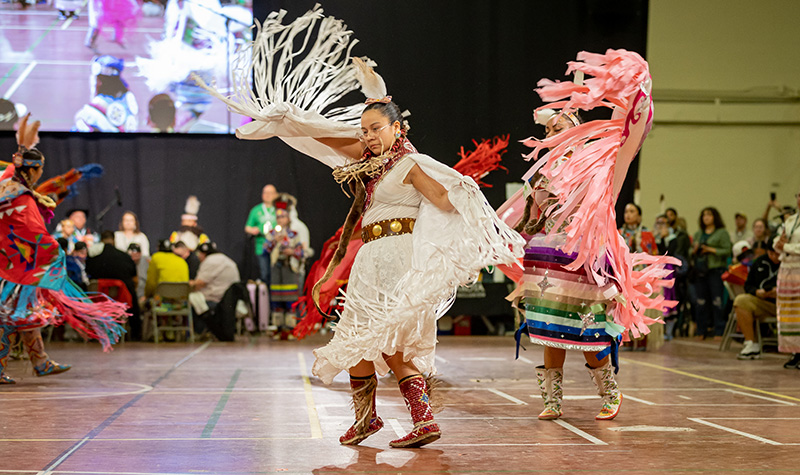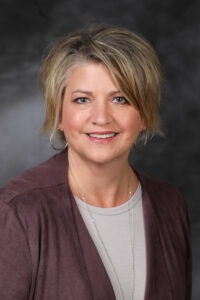‘All you see is happy all around’
With spectacular flair, 50th annual Time Out Wacipi Powwow returns to UND after long pandemic break
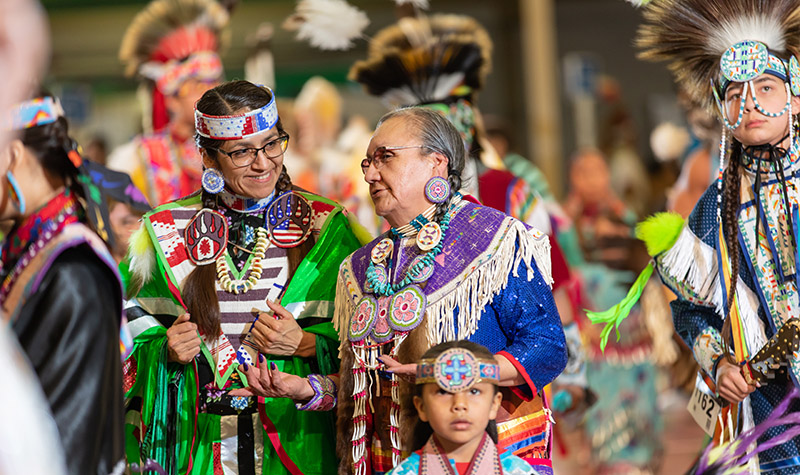
Thousands of people from near and very far said it was good to be back. And it was even better to be back after a two-year break.
The 50th Time Out Wacipi Powwow returned to UND’s Hyslop Sports Center this weekend for the first time since the pandemic shut it down for 2020.
“I feel like we should have the powwow every year,” said Christina Poitra of Belcourt, N.D. “This is medicine for the Native People. This is what gives us a quiet spirit.
“Look, we have all walks of nation here. This is a celebration we want to share with our children. They can see in all reality that Native People are united, especially at a powwow.”
And it certainly was a celebration both Friday and all day Saturday, as 19 drum circles took turns in exuberant song, keeping the dancers moving to the beat inside another giant circle of metal folding chairs four rows deep.
Still more dancers and spectators populated the arena stands above as they rested or munched on tulip snow cones and fry bread. Other participants browsed handmade arts and crafts, including everything from carved bears to blankets and beads, fancy dream catchers and “rattlers” made from the shells of the red-eared slider turtle.
It was a full house, and there was much to see, hear and experience.
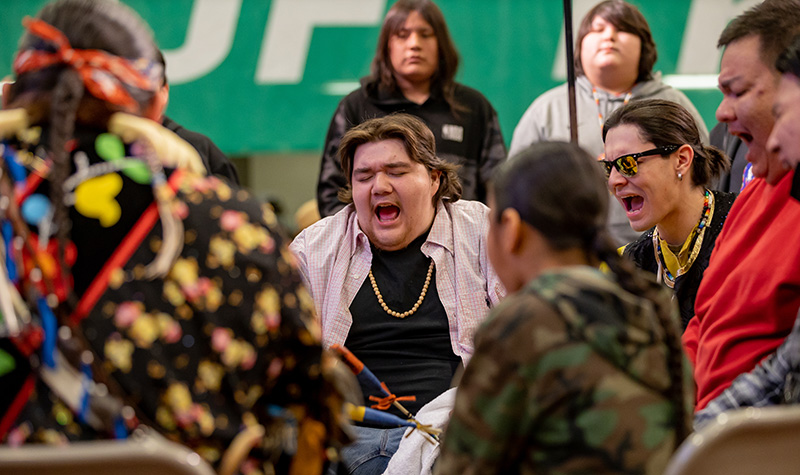
Sights and sounds
There were traditional dancers with beautifully beaded regalia, “bone” breastplates and eagle feather bustles, plus decorative crowns of porcupine quills atop the dancers’ heads. Others wore full-feathered headdresses — like a rounded bonnet — constructed of eagle feathers or the feathers of other flying beauties such as hawks, ospreys or owls.
Just as bright were the grass dancers covered shoulder to ankle with flowing ribbons of colorful fringe. Then, there were the fancy and fancy shawl dancers. The chicken dancers. And the jingle dancers who prayed for healing with their constant, sweet melody of tinkling tin.
“This is my first powwow, and the Grand Entry was the most impressive part of the night so far for me,” said UND President Andy Armacost. “All of a sudden, I saw more and more people coming out of the back. The procession just didn’t end. All of the pageantry, the beautiful colors and the ceremonial headdresses — everything about it was absolutely stunning.
“There’s an energy here that is just incredible. And there’s an excitement gathering as part of the community, particularly our Native American communities. This is what it’s all about. It’s about those connections and being together and celebrating life.”
Victoria “Judy” Brugh echoed the president’s thoughts. The 12-year councilwoman for Three Affiliated Tribes in New Town, N.D., said she’s been going to powwows all her life.
“I love it. It’s our culture and our heritage,” Brugh said. “COVID put such a damper on everyone’s life. It’s wonderful to socialize and see our friends again. Everybody is all dressed up. The whole atmosphere is festive. All you see is happy all around. You don’t see any sadness.”
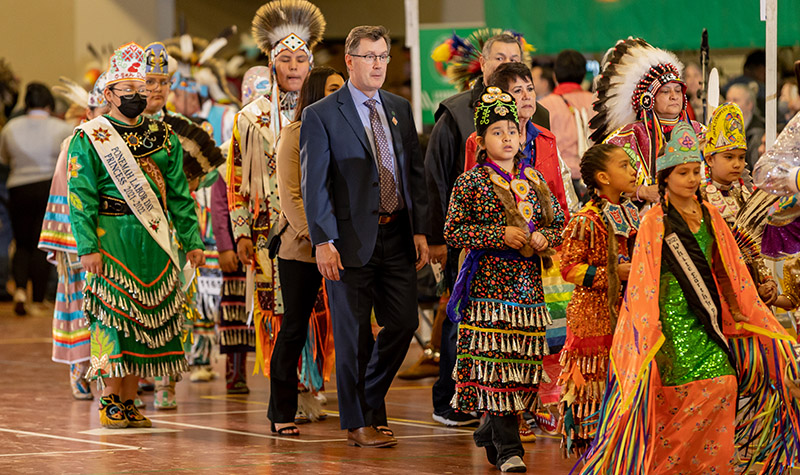
It takes you back
Alex Wells said much the same. Though he’s traveled to hundreds of powwows in his lifetime, the 26-year-old member of Spirit Lake Nation in Fort Totten, N.D., said he was especially happy to see the return of Wacipi.
“First of all, I’m really nostalgic,” he explained. “I grew up coming to this powwow all my life. My grandpa, Elmer White Sr., was the former Spirit Lake chairman, and he used to announce here. A lot of good memories are coming back. And there are a lot of good feelings reuniting with friends on the powwow trail.”
Of course, Wacipi also gave him the chance to break out his “pride and joy.” By that, he meant his contemporary powwow vest and moccasins his mother and sister designed, hand-beaded and gifted to him.
Each dancer’s regalia was more magnificent than the next. That’s because it all was very personal and meaningful for each individual.
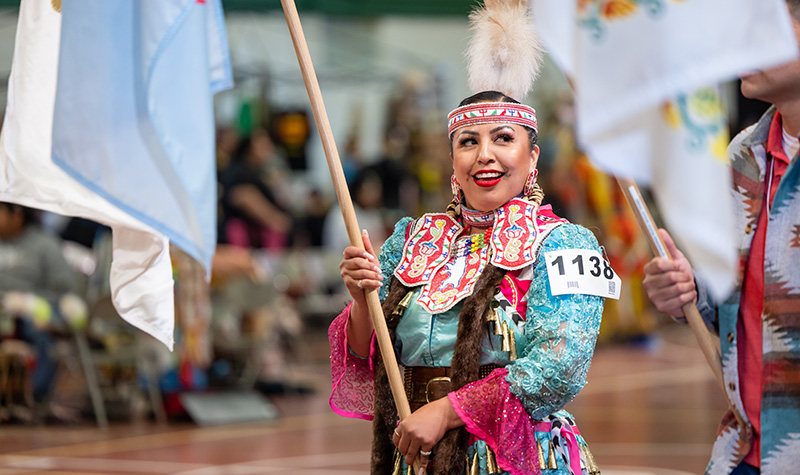
In fact, UND’s retired longtime Director of American Indian Student Services Leigh Jeanotte said that people often pass their regalia from generation to generation.
“Some of that is really very old,” he said. “But then a lot of times, they’ll add to it from year to year. Our powwow typically was the earliest one of the powwow season. So, we were kind of the display powwow for all the work everyone had done throughout the winter.”
And with everyone cooped up for so long, there probably was more time than usual for that handiwork.
“COVID has been kind of rough on us,” Jeanotte said. “So this really is a time to celebrate and get past some of the pain and hardship that American Indians have faced.”
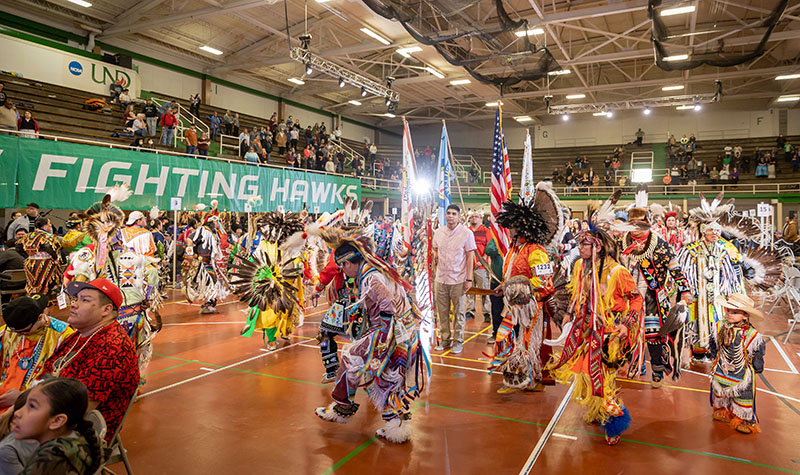
On the road
And now that the powwow circuit is finally geared up again, longtime emcee Charlie Moran from New Town-Mandaree, N.D., said people will have many more to look forward to in the coming months.
He shows proof of that with a quick flash of his cellphone calendar. During the school year, he’s a teacher and sports announcer; but from now until mid-September, he is booked every weekend for powwows — or what he prefers to call “doings” — throughout the Midwest and Canada.
He wouldn’t do it if he didn’t love it, he says. And he’s been loving it for at least 25 years, having started at an unusually young age for a powwow announcer. He fell into the gig after older announcers kept calling on him to read the small writing on the handbills.
“We have to keep these traditions, our language, our values, our culture and customs alive,” he said. “As a historian, I know it’s so important for our children.”
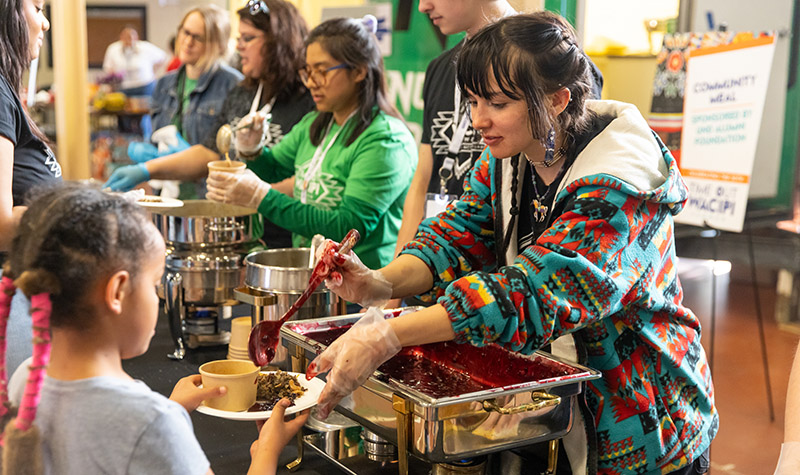
More of what we heard …
Here’s a few more snippets of conversations we heard during the two-day event …
Christina Poitra of Belcourt, N.D.: Talking about her young daughter, Jada Jeanotte … “This girl is meant to dance. The powwow life is for her. Ever since she won her regalia, she hears the drum everywhere. She was just meant to be a medicine dancer. I don’t know how many spectators we had watching her dance in the dang Walmart aisle. You would have thought she won Miss America.” Jeanotte just recently passed on her crown as Turtle Mountain Pembina Junior Princess.
Abel Vazquez, Grand Forks: “It seems like (the powwow) came back in full force. It felt like it was half the size in 2019. It’s really nice to see how many people actually came out for it. I’m originally from Mexico, and we have powwows there, but they’re a little different. I love the sense of community. Coming here just kind of makes me feel a little more at home.”
UND graduate and retired Dunseith, N.D., art teacher Alfred DeCoteau: “I’ve been carving for about 40 years, and all that I do represents something to do with the Native American culture. These are not just carvings I do for the sake of carving a bear. There’s meaning and symbolism behind everything.”
Artist Bill Brien, son of artist Bennett Brien: His wife, Geri Rei Brien, whom he met at UND in 2009, died of cancer in 2018. He said her powerful strength inspired him to tell her story through artwork. “Being back here is exciting and bittersweet at the same time,” he said. “It’s fun being able to run into family and friends I haven’t seen in a while. It’s nice to share the artwork, and I know Geri is here in spirit.”

Donovan Abbey, Mandaree, N.D.: He had traveled to the powwow with his wife, three daughters and a young son he expertly juggled to get dressed while talking to a reporter. “It’s nice to get a little bit of normalcy back and to get the powwow put back on our schedule.”
Daughter Tessa “Holds the Enemy” Abbey, Mandaree: She shared how she became the Denver March Princess. “Usually for the much bigger powwows, you have to run for it, but for Denver (Colo.) March, they look around for young people in the crowd. They look at how you carry yourself, if you enjoy yourself in a good way and how you represent your family and your tribe.” She said her favorite part of Wacipi is getting to see family and friends — both from home and from her “powwow family who really become like close friends or family.”
Pauline Hamlin, Red Lake Nation, Bemidji: “Sometimes our family goes in separate directions, so it’s fun to get together and see all my nieces here. I’m enjoying everyone. Everyone is having a great day.”
